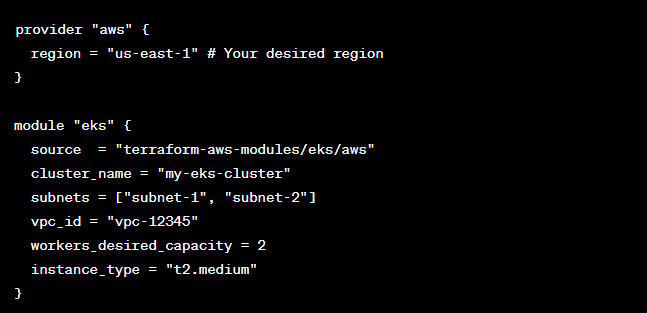Introduction
Amazon Elastic Kubernetes Service (EKS) is a managed Kubernetes service that simplifies the deployment, management, and scaling of containerized applications. When combined with Terraform, an infrastructure as code (IaC) tool, you can easily provision and manage your EKS cluster. This article will guide you through the process of setting up an Amazon EKS cluster using Terraform, providing a powerful and efficient way to manage your Kubernetes infrastructure.
Why Use Terraform for Amazon EKS?
Before diving into the provisioning process, it's essential to understand why Terraform is a valuable tool for managing Amazon EKS clusters.
Infrastructure as Code (IaC)
Terraform allows you to define your infrastructure as code, making it easier to version, share, and replicate your environment. With Terraform, your EKS cluster configuration becomes human-readable and reproducible, eliminating manual setup errors.
Scalability
EKS clusters often require scaling to meet varying workloads. Terraform provides a way to scale your infrastructure effortlessly by modifying configuration files and applying changes. No need to manually intervene when your workloads grow or shrink.
Collaboration
With Terraform, you can collaborate with your team effectively. Version control systems like Git can be used to store and manage Terraform configuration files, enabling collaborative infrastructure management.
Prerequisites
Before we begin, ensure you have the following prerequisites in place:
- An AWS account with the necessary permissions.
- Terraform installed on your local machine.
- AWS CLI installed and configured.
- kubectl, the Kubernetes command-line tool.
Steps to Provision an Amazon EKS Cluster
Now, let's walk through the steps to provision an Amazon EKS cluster using Terraform.
1. Define Your EKS Cluster Configuration
Create a Terraform configuration file, typically named eks.tf. In this file, you'll define the necessary AWS and EKS resources, such as VPC, subnets, security groups, and the EKS cluster itself.
2. Initialize and Apply the Configuration
Run the following commands to initialize the Terraform configuration and create the resources:
Terraform will analyze your configuration and provide a plan for the resources it intends to create. Confirm the changes, and Terraform will provision your EKS cluster and associated resources.
3. Configure kubectl
After the cluster is provisioned, configure kubectl to interact with the EKS cluster:
4. Verify Your Cluster
To verify that your EKS cluster is up and running, run the following command:
This command should display a list of nodes in your EKS cluster, indicating that your cluster is operational.
Conclusion
Provisioning an Amazon EKS cluster with Terraform offers a robust, scalable, and efficient way to manage your Kubernetes infrastructure. By defining your infrastructure as code, you ensure that your EKS cluster configuration is versioned, reproducible, and easy to collaborate on with your team.
With the right prerequisites and these steps, you can set up your Amazon EKS cluster quickly and easily. Start leveraging the power of Terraform to streamline your Kubernetes infrastructure management today.




